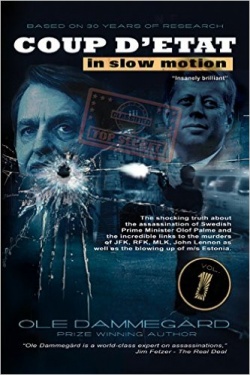Coup d'etat in slow motion
 | |
| Type | book |
| Publication date | 2013 |
| Author(s) | Ole Dammegård |
| Subjects | Olof Palme/Assassination, Bernt Carlsson, Sanya Popovic |
| Original language | Swedish |
| Original title | Statskupp i slowmotion |
| An in-depth analysis of the events and politics surrounding the assassination of Sweden's Prime Minister Olof Palme. | |
Coup d'Etat in Slow Motion (Swedish title Statskupp i slowmotion) is a book by Ole Dammegård about the assassination of Olof Palme, published in 2013.
Contents
Extracts
Foreword by Police Chief Gösta Söderström
On the night of February 28, 1986, I headed the police patrol first at the site of the murder of our prime minister and thereby found myself in the middle of one of the largest political and legal scandals of the 20th century in Sweden. Ever since then I have gradually come to the conclusion that the responsible authorities have primarily tried to cover up the event. I have read many books, official documents, newspaper articles, etc, and have also spent thousands of hours both alone and together with serious private persons trying to find the truth about this murder. Among the more interesting books I would like to mention ”Coup d’etat in Slowmotion”. What has been most interesting to me is the fascinating story, the extensive research and also the information concerning global Free Masonic networks. Therefore I give this book my very best recommendations to all those who are interested in the murder of Olof Palme and the reasons behind it.
Author's Introduction
In 1986, something very tragic happened in Sweden. Prime Minister Olof Palme was brutally assassinated on a street in central Stockholm. This was something that nobody had ever considered possible, and the Swedish people was paralysed by grief.
“600 years ago, a church had been erected on the corner of Tunnelgatan – Sveavägen, and we had been given a new saint, Saint Olof”, explained Hampus Lyttkens, retired professor of religious philosophy in Lund. “This is exactly how saints were created in earlier times, a hero who became a martyr and was endowed with mythical dimensions.”
After some years of futile chasing in all directions, the leaders of the manhunt agreed that the murder was most probably an act of lunacy carried out by a “lone looney”. The name of the person pointed out, accused, sentenced and later even acquitted was Christer Pettersson (who died under violent circumstances and who can no longer defend himself). He is still today (spring 2013) the one who is guilty, in both the eyes of the leaders of the manhunt and most of the media. But is the solution really that simple?
The assassination shook the entire world and overnight Sweden changed face from an idyllic small nation without corruption and violence to become part of the tough and ruthless world around it. Even politics changed course.
“Without Palme, Sweden became a more normal country, that is to say that later governments did not strive to change the rest of the world”, stated Richard Burt, former assistant foreign minister of the United States in the TV programme Dokument Utifrån. “Instead, the Swedish governments started doing as other governments, focusing on questions concerning the local area. After Palme there were no Swedish global politics.”
The shots on Sveavägen simultaneously shook the electorate. After a decline in February, the social democrats experienced an increase of six per cent during the month following the assassination. That sympathy for the party is an international pattern which could also be seen after John F. Kennedy was shot to death in Dallas as well as after the attempted murders on President Reagan and Prime Minister Margaret Thatcher. Even changes in domestic politics took place, such as a more positive attitude on the labour market towards the employers, the abolition of wage-earners’ funds, reduced taxes for high-income earners, advertisement sponsored television, the disintegration of the welfare state, the increasing gap between the rich and the poor as well as the connections with the EU – none of this would have happened during the reign of Palme.
On Bernt Carlsson
In pages 601-605 and 661-662 Dammegård suggests that South African President P W Botha was responsible for the murder of both Olof Palme and Bernt Carlsson:
- "Swedish national, Bertil Wedin, who was recruited by South African superspy Craig Williamson, said:
- 'I have the names of businessmen who know a lot about this – many things the investigators would need to know. A lot of information has been silenced.'
- "According to Swedish newspaper Aftonbladet of 30 April 1991, Bernt Carlsson’s American girlfriend, Sanya Popovic, was told by him shortly before the Lockerbie catastrophe:
- 'I am one of the four or five people who know what really happened to Olof Palme'.
- “A diplomat (probably, Bernt Carlsson) knew about this, and told his friends in New York that he was afraid for his life. Some days later, he was one of the victims in the Lockerbie outrage of December 21, 1988, when Pan Am Flight 103 was blown to pieces over a small village in Scotland. In all, 270 people were killed. Bernt Carlsson was Palme’s closest co-worker in the mediating assignment between Iran and Iraq, and no doubt had insight into all aspects.
- "At the time of his death, Bernt Carlsson – who was a sworn adversary of Apartheid – had just been appointed UN Commissioner for Namibia, and was seen as a serious threat by the white regime of South Africa.
- "Because Bernt Carlsson knew too much, he had to be removed.
- "Investigations by the Austrian newspaper Kronen Zeitung, proved that in fact South African agents had placed a specially-prepared bomb in Bernt Carlsson’s small tape recorder.
- "By blowing up a whole passenger plane in the air, the motive was hidden very effectively, because the investigators had no possibility of knowing which one of the passengers was the target."[1]